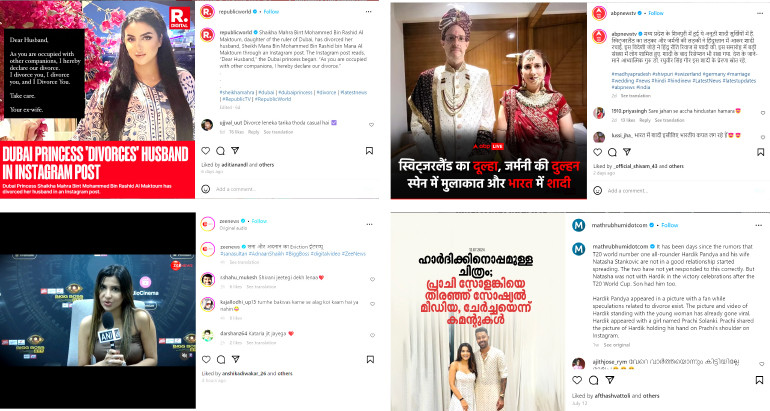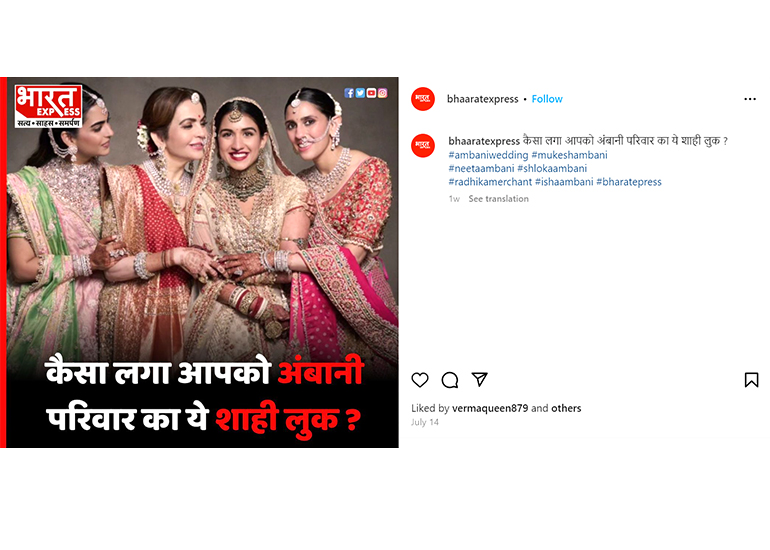As Barkha Dutt puts it, “News is tamasha and what really bothers me is that people criticise it, but still watch it. People like to watch tamasha.”
In today’s hyper-connected tamasha-loving world, news channels find themselves at a crossroads: should they chase the fleeting allure of virality or adhere to the principles of substantive reporting? The rise of social media has redefined how news is consumed, with prominent news platforms’ social media pages frequently featuring viral content, ranging from celebrity tweets to popular trends. While this approach captures immediate attention and boosts engagement, it raises critical questions about the integrity of journalism. Are news channels prioritizing clicks over credibility, or is this the future of news?
During the COVID-19 lockdown, social media surged in popularity as people sought ways to stay connected and entertained while confined at home. Additionally, it became a lifeline for the masses to reach out for help. Overall, for a generation with the attention span of a fly, social media became a go-to tool for news updates.
Most news channels today adopt distinct strategies for their social media platforms, aiming to maintain a 24/7 presence. The content posted on social media is generally more frequent and abundant compared to their traditional broadcast and media outlets. This approach ensures constant engagement and up-to-date information for their audience, leveraging the immediacy and reach of social media.
 Vijay Jung Thapa, Chief Digital Officer, ABP Network notes that for social media there are a lot more categories. “Right now, TV is very politics-heavy, there is a lot of news on parliament and political leaders but we do a lot of non-news as well—we do technology, personal finance, and things that are now trending on social media,” he says.
Vijay Jung Thapa, Chief Digital Officer, ABP Network notes that for social media there are a lot more categories. “Right now, TV is very politics-heavy, there is a lot of news on parliament and political leaders but we do a lot of non-news as well—we do technology, personal finance, and things that are now trending on social media,” he says.
ABP Network’s social media page, ABP Live, has dynamically covered high-profile events such as the extravagant Ambani wedding, and trending moments like Parineeti Chopra and Raghav Chadda attending Wimbledon 2024. Simultaneously, they have reported on significant news topics, including the event surrounding Trump’s assassination attempt. Tapan Sharma, Chief Operating Officer, Republic Digital Business observes that when it comes to traditional news broadcasts, there’s a specific audience that tunes in daily at set times, like 9 p.m. for a special show or 10 p.m. for breaking news. This is a one-way, time-bound interaction. However, social media audiences prefer consuming content at their convenience on platforms like YouTube, Facebook, Instagram, or WhatsApp. “The social ecosystem is demand-based, not supply-based. People demand from a social media platform. And it is important to cater to the demand of these platforms and the communities on the platform” he adds.
Tapan Sharma, Chief Operating Officer, Republic Digital Business observes that when it comes to traditional news broadcasts, there’s a specific audience that tunes in daily at set times, like 9 p.m. for a special show or 10 p.m. for breaking news. This is a one-way, time-bound interaction. However, social media audiences prefer consuming content at their convenience on platforms like YouTube, Facebook, Instagram, or WhatsApp. “The social ecosystem is demand-based, not supply-based. People demand from a social media platform. And it is important to cater to the demand of these platforms and the communities on the platform” he adds.
Media organizations like Zee News frequently feature content about reality TV shows like Bigg Boss and celebrity birthdays, such as Katrina Kaif’s, alongside significant political events like Modi’s visit to Moscow or Rahul Gandhi’s parliamentary debates. But to address the question of whether news channels are balancing the need for viral content on social media to maintain credibility, Anindya Khare, Marketing Head, Zee Media Corporation Ltd. says that for them the primary platform is Television and they create platform-specific content to ensure that views and revenue are maximized. Talking about credibility he says, “It’s a two-edged sword: if news channels ignore trends, viewers feel left out and believe the channel isn’t up-to-date. Conversely, if they overdo it, it results in content overload. To balance, we provide essential insights on critical trends without excessive coverage, ensuring viewers stay informed without feeling overwhelmed.”
But to address the question of whether news channels are balancing the need for viral content on social media to maintain credibility, Anindya Khare, Marketing Head, Zee Media Corporation Ltd. says that for them the primary platform is Television and they create platform-specific content to ensure that views and revenue are maximized. Talking about credibility he says, “It’s a two-edged sword: if news channels ignore trends, viewers feel left out and believe the channel isn’t up-to-date. Conversely, if they overdo it, it results in content overload. To balance, we provide essential insights on critical trends without excessive coverage, ensuring viewers stay informed without feeling overwhelmed.”
Tapan Sharma observes that they are not the only ones covering this content; around 500 publishers will also cover it since it’s already in the public domain. Before news channels pick it up, platforms like YouTube, Facebook, Instagram, and social media influencers have already shared it. They take what’s available, present it to the community without adding any opinion, and fulfil demands by sharing content on their platform where they prefer to consume it. “It’s a very distributed ecosystem. If I watch a certain news channel, I would want to watch it for everything that I know,” he adds. But news channels need to be cautious even when they are just trying to grab eyeballs. Rakesh Gopal, Chief Revenue Officer, Bharat Express says social media is crucial for reaching wider audiences, but the core focus remains on traditional media. “We must ensure credibility on social media because what we post impacts our mainstream media’s reputation. Even when chasing viral trends, we carefully select and differentiate content to maintain our channel’s trustworthiness. Balancing this is key to preserving the integrity of our primary media platforms” he notes.
But news channels need to be cautious even when they are just trying to grab eyeballs. Rakesh Gopal, Chief Revenue Officer, Bharat Express says social media is crucial for reaching wider audiences, but the core focus remains on traditional media. “We must ensure credibility on social media because what we post impacts our mainstream media’s reputation. Even when chasing viral trends, we carefully select and differentiate content to maintain our channel’s trustworthiness. Balancing this is key to preserving the integrity of our primary media platforms” he notes.
Bharat Express has also ventured into content appealing to the youth, like covering the Ambani wedding, though to a lesser extent than its competitors. Their Instagram page features content that often falls into non-news viral material. Shradha Agarwal, Co-Founder and CEO, Grapes notes that the prime focus of the channels should be to maintain the accuracy and substantiveness of the news. She adds that before circulating any content, it is essential to conduct a thorough verification of the information.
Shradha Agarwal, Co-Founder and CEO, Grapes notes that the prime focus of the channels should be to maintain the accuracy and substantiveness of the news. She adds that before circulating any content, it is essential to conduct a thorough verification of the information.
Anindya Khare spoke on similar lines about how Zee News has a social media team of fact-checkers who check the authenticity of the news and decide whether the news should be published on media platforms.
Initial viewership for viral social media content, like India winning the T20 World Cup, is immense. However, the virality of a news channel does not last forever and typically fades after a few days or months. Vijay Jung Thapa says “Viral videos may last for a few days, but well-crafted explainers relevant to my audience have an enduring value. These explainers are repeatedly used and viewed over time. If you compare engagement and views over a year, they outperform fleeting viral content like an Ambani wedding.” Joseph Kumpa, Head - Social Media, Mathrubhumi Printing and Publishing Co. Ltd. says there is a variety of content available, including entertainment-related news, hard politics, and in-depth analysis. “Publishers focusing on hardcore politics on social media may have a smaller audience compared to popular contents like the Ambani wedding, general incident reporting, cinema beat, etc. However, people are often willing to pay for in-depth political analysis and in-depth niche content,” he adds
Joseph Kumpa, Head - Social Media, Mathrubhumi Printing and Publishing Co. Ltd. says there is a variety of content available, including entertainment-related news, hard politics, and in-depth analysis. “Publishers focusing on hardcore politics on social media may have a smaller audience compared to popular contents like the Ambani wedding, general incident reporting, cinema beat, etc. However, people are often willing to pay for in-depth political analysis and in-depth niche content,” he adds
Is the Indian audience ready to rely on social media as the primary news source in the coming years? Opinions vary, some say yes, others say no, while many believe it will coexist alongside traditional broadcast news.
Social media plays a crucial role in news consumption, especially among younger audiences who frequently browse their feeds for interesting content. When a topic captures interest, the audience often seeks more in-depth information from traditional media. Thapa believes that social media is after all a gateway to the world of in-depth news reporting.
“This trend isn’t limited to younger people; even those over 35 who use social media less, will delve deeper into subjects that they find important. Social media essentially acts as a gateway, helping users curate and decide how deeply they want to explore a topic” says Vijay Jung Thapa.
Rakesh Gopal belongs to the other side of the debate as he opines that while social media is crucial for spreading information, it will never replace traditional media like Television and Print in terms of credibility. “Traditional media remains the trusted source. Social media can be prone to scams and misinformation, but traditional media upholds standards that maintain trust. By supplementing traditional media with social media, we enhance our reach while maintaining credibility.” he adds.
Joseph Kumpa says young people or social media users are interested in news, but its appeal depends on its presentation. “Sticking to traditional delivery methods might result in less engagement. Balancing the need for viral content with the responsibility of maintaining credibility is crucial. In the end, credibility remains paramount in any approach.” he notes.
Keeping the debate about social media becoming a primary source of news aside, media outlets have been striving to go viral and drive traffic to their sites by publishing content that encourages users to click and read. Some even observe that younger audiences are more inclined towards such content. Thus, the dilemma remains: What does the audience prefer? Tamasha or Truth?






















